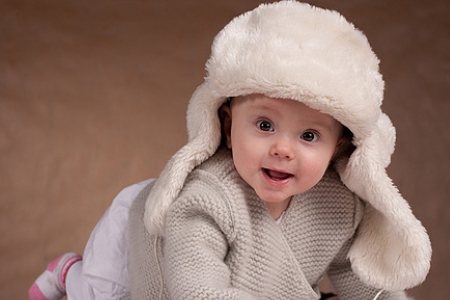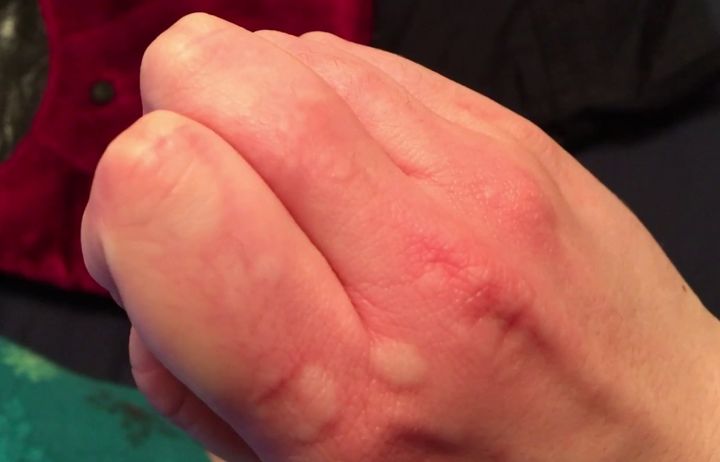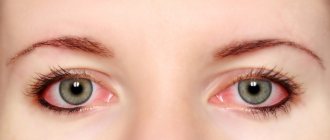Why is cold intolerance dangerous?
Every parent knows the dangers of a cold, flu or other common illnesses. However, few people pay due attention to cold allergies. Many simply eliminate the symptoms that have arisen, but do not fight the mechanism of development of the response. Among the main complications of this condition are:
- Quincke's edema.
- Anaphylactic shock.
- Swelling of the larynx.
Allergies to cold in children can provoke rapidly developing allergic reactions. This leads to complications such as bronchial asthma or a decline in immune abilities.
Causes of the disease
The main factor in the appearance of an allergic reaction to cold is hypothermia. Typically, this problem occurs in winter, when the body is most susceptible to hypothermia. Cold allergies occur due to reasons:
- Genetic predisposition - if a parent suffers from hypersensitivity to cold, then the child will probably also have it;
- Taking antibiotics – such medications significantly reduce the body’s immune capabilities;
- The influence of chronic diseases - they also weaken the immune system, which also reduces immunity;
- The presence of dermal diseases - psoriasis, dermatitis, other allergies can cause an excessive reaction to the skin;
- The consequences of stress are especially dangerous for particularly excitable and impressionable children.
Types and symptoms of allergies to cold
Signs of cold allergies appear about 30-40 minutes after contact with the pathogen. The child begins to complain of discomfort upon arriving home. He begins to show signs:
- Painful sensations on the dermis, itching and burning on the hands and face;
- Swelling of tissues, formation of red areas, blisters, peeling;
- Over time, such signs spread to the thighs, legs, and knees.
Additionally, children may experience a cough and runny nose. Usually, when the child gets into a warm room, such signs disappear. Tears may also occur, which indicate allergic conjunctivitis.
In rare cases, a skin reaction to cold is accompanied by vomiting, shortness of breath, and a feeling of fatigue. This is how allergies to extreme cold manifest themselves in children and newborns.
Cold urticaria
An allergy to cold in a child is one of the most common forms of response. Blisters and swelling quickly appear on the skin. All children who have increased sensitivity of the skin are susceptible to this condition.
Pseudoallergic conjunctivitis
Pseudoallergic conjunctivitis often torments children. It develops against the background of cold exposure to the eyes, which is why they begin to produce an excessive amount of tears. There is also a burning sensation. The discomfort goes away only after warming up.
Cold rhinitis
Cold rhinitis is characterized by the appearance of a runny nose after a short stay in the cold. Anticonvulsant drops or antihistamine complexes help ease the course. Most often, this condition occurs in infants.
Cold dermatitis
Cold dermatitis is a response of the skin to the consequences of contact with cold. Only exposed areas of the skin are affected. Over time, inflammation and small cracks appear on them. For treatment, medications are prescribed that improve blood circulation.
Cold asthma
When exposed to cold air, a child experiences bronchospasm. It can be recognized by a slight numbness of the tongue and increased pressure in the throat. The airways narrow, making it harder to breathe.
Complications of cold allergies
The occurrence of an allergy to cold on the skin of the face or other areas without full correction has a powerful negative effect on the body. It has a special impact on the mental state of the child.
Quite often, due to cold allergies, children experience nervousness, apathy, increased fatigue, and develop depressive moods.
What is cold allergy?
An allergy is a specific reaction of the body's immune system to a particular protein. Due to disturbances, the nature of which has not yet been clarified, the body perceives completely harmless substances as harmful.
But in the case of cold, we are talking more about physical effects, so for a long time doctors did not consider cold allergies in a child to be a real disease. No allergen means no allergies. However, there are now several theories about how an allergen appears in the body under the influence of cold. According to one theory, when the blood cools, a precipitate of special proteins appears in the blood: cryoglobulins. They cause an allergic reaction.
The second theory states that cold causes a reaction between blood proteins, as a result of which a new, more complex protein appears, and this, in turn, is an allergen. Then, in both cases, the same thing happens as in the case of a normal allergy: immunoglobulin E is produced, which stimulates the production of histamine.
Symptoms
The signs of a cold allergy are not much different from any other. That is, the manifestations can be quite diverse. Most often, cold allergies appear on the face and hands, that is, in those places that usually come into contact with cold air. The skin of the hands and face turns red, becomes covered with a dense pink rash, begins to itch very much, sometimes peels and cracks . In particularly severe cases, the rash may also appear on the legs, usually on the inside of the legs and thighs. In these places the skin is most sensitive.
Cold allergy symptoms may resemble a common cold: runny nose, difficulty breathing, cough . Sometimes the child may even experience bronchial spasm. In some cases, an allergy to cold manifests itself as a severe headache. It is noteworthy that if you insulate your head additionally, there are no problems with pain.

When returning to warmth, as a rule, all symptoms disappear quite quickly. However, in some cases they persist for several more hours.
Many people believe that allergies to cold are a seasonal phenomenon and are typical for winter. In fact, this is not true at all. An allergy to cold can begin even from eating ice cream in the heat, let alone contact with cold water, piercing wind, and so on. Moreover, an allergic reaction is more typical in the spring and autumn periods, when, firstly, it is more difficult to choose clothes for the season, and secondly, cold winds blow.
Be careful not to get confused!
However, the appearance of irritation after a winter walk is not always a cold allergy. In fact, this could be, for example, a reaction to the fur trim of the hood on a child's jacket or to a new turtleneck sweater.
Also, sometimes parents confuse a disorder such as Raynaud's syndrome - excessive sensitivity of blood vessels to cold - with a cold allergy in children. This syndrome begins to manifest itself from the fingers: they turn white, begin to freeze and hurt. Since this syndrome often accompanies various rheumatic diseases, it is necessary to urgently consult a rheumatologist.
Why do allergies to cold occur?
Unfortunately, the work of the immune system is still too poorly understood, and doctors have still not been able to figure out where cold allergies come from in children. It is known that there is a hereditary predisposition to this disease. Therefore, it makes sense, before consulting a doctor, to try to completely change the child’s outer clothing, eliminating the presence of allergens in it.

In addition, cold allergies rarely occur in completely healthy people. As a rule, it occurs against the background of serious infectious diseases or accompanies chronic disorders. Considering that both of them often tend to be asymptomatic, at the first signs of an allergy to cold it is worth not only starting treatment, but also undergoing a full examination to determine what exactly caused the allergy.
Diagnostics
Diagnosing cold allergies in children is not particularly difficult. It is usually based on studying the clinical picture. In some cases, a special test is performed. It allows you to make the correct diagnosis with high accuracy. You can identify allergies to cold at home. To do this, research is carried out:
- Apply an ice cube to the skin for 5-7 minutes, then evaluate the skin's reaction.
- Immerse your hand in cold water for 10-15 minutes, then expect changes.
- Try letting your child out into the cold for 5 minutes in warm clothes.
If after performing such tests there is no reaction from the skin, then the child does not have an allergy. When it is present, characteristic symptoms appear: the skin becomes inflamed, pain, rashes appear, and the general condition worsens. In this case, it is recommended to consult a doctor.
Symptoms of frost allergy
How does cold allergy manifest? The disease has the following symptoms:
- Headaches in the occipital and frontal parts. A rash appears on the face and hands, itching, swelling, burning begins, and in some situations the legs itch after frost.
- Dryness and cracking of the skin on the hands. The face and limbs swell.
- Runny nose, itching and nasal congestion. Sore throat, cough in the cold, watery eyes, itching and redness of the eyes.

Allergy to frost - symptoms and treatment
Treatment of cold allergies
Many are sure that cold allergies do not exist as such: since there is no allergen, then the disease cannot exist either. In fact, allergic reactions to cold exist and occur frequently. This condition requires mandatory and immediate treatment. Ignoring this disease leads to spasm of the respiratory tract, which leads to serious complications including death.
What to do first?
When the first signs of an allergy to extreme cold appear in infants, immediately take the child to a warm room. It is strictly forbidden to warm the skin with water. The parent also needs to protect the child from other provoking factors, such as:
- Cold water.
- Any cold objects.
- Chilled food.
After this, do everything possible to alleviate the allergic reaction. To get rid of itching, you can make special soda lotions. When purulent or weeping wounds form, it is recommended to apply a solution of brilliant green to them.
Treatment of allergies to frost
What to do if, when exposed to low temperatures, a skin reaction occurs in the form of redness, rash, itching and burning, a runny nose, coughing, watery eyes, etc.? In such a situation, it is necessary to visit a doctor for diagnosis and further treatment of the disease.
You can do a frost allergy test yourself at home. To do this, place a piece of ice on the crook of your elbow for a few minutes. If the skin turns white or red, itching begins, then there is a high probability of having an allergic reaction to the cold. For an accurate determination, you need to consult a therapist or immunologist-allergist and undergo an examination.
Cold allergy is treated similarly to other types of allergies. The main condition is to avoid contact with the allergen, i.e. cold. It is worth considering a number of features. Allergies manifest themselves when going out into frosty air, when taking ice-cold drinks and food, or when interacting with cold water. Each person has their own degree of sensitivity: in some, urticaria appears at temperatures of -22...-30 degrees, in others - at -5...-10 degrees, in others - upon contact with cold water (+5...+10 degrees).
Unfortunately, it is not always possible to avoid contact with the cold. Therefore, additional medications are prescribed. How to treat allergies from cold, what to use? This could be an antihistamine or bronchodilator. A plasmapheresis procedure may be prescribed.

Medicines prescribed for the disease are listed in the table
| Type of drug | A drug | Release form |
| Antihistamines | Tavegil | Pills |
| Zyrtec | Pills | |
| Suprastin | Pills | |
| Claritin | Pills | |
| Loratadine | Pills | |
| Tsetrin | Pills | |
| Levocetrizine | Pills | |
| Cetirizine | Pills | |
| Fexofast | Pills | |
| Parlazin | Tablets, nasal drops | |
| Allergodil | Nasal drops | |
| Fenistil | Nasal drops | |
| Skin cap | Cream | |
| Elokom | Cream | |
| Soderm | Cream | |
| Bepanten | Cream | |
| Gistan N | Cream | |
| La Cree | Cream | |
| Auxiliary preparations for skin irritation and itching | Panthenol | Spray, cream foam |
| Depanthenol | Cream | |
| Bronchodilators | Salbator | Aerosol |
| Troventol | Aerosol | |
| Fenoterol | Aerosol | |
| Ipradol | Aerosol | |
| Salmeterol | Aerosol |
Important! Medicines should only be prescribed by a doctor after consultation and examination.
Prevention
Prevention of cold allergies in children is simple. To minimize the risk of such a reaction in the child’s body, it is enough for parents to do everything possible to eliminate the effect of cold on the skin. To do this, check how the child is dressed and monitor his clothes. Sensitive areas of the skin are additionally protected.
Also, review your child's diet. It is very important to switch him to proper nutrition. Try to exclude flour, fatty, fried, and various sweets. The menu should be dominated by fresh vegetables and fruits, fish, and lean meats.
Causes of allergies
There may be several main reasons for the appearance of an allergy to frost:
- The baby spends most of his time indoors, rarely goes outside, and leads a sedentary lifestyle.
- There is an infectious disease (hepatitis, herpes, etc.).
- The presence of chronic hereditary congenital or acquired diseases (for example, tonsillitis, pyelonephritis, sinusitis).
Sometimes cold urticaria is inherited. The disease appears at six months of age. In rare cases, a hereditary predisposition in children manifests itself from birth. After 1-2 hours, even after slight cooling (from a draft, for example), a rash appears on the baby’s skin, body temperature begins to rise, conjunctivitis occurs, etc.
Sometimes cold allergies in children signal the emergence of a new disease (infectious or related to the immune system), so doctors refer a general and biochemical analysis of blood, urine, and rheumatic tests so that the correct treatment can be prescribed.
Recommendations for parents
If your child suffers from cold allergies, then this circumstance must always be remembered. To minimize the risk of exacerbation of the disease, eliminate or at least minimize the effect of the allergen on the body. Among the main recommendations:
- Do everything you can to keep your immune system normal.
- Take vitamin supplements in spring and summer.
- Do not allow your child to become hypothermic or overheated.
- Monitor your child’s diet: it is necessary to exclude fatty, fried, sweets, and citrus fruits from his diet.
- Try to reduce the time your child spends outside during frosts.
- Make sure that all parts of your body are covered when walking in cold weather.
- An hour before the walk, it is recommended to treat the skin with a protective cream.
- Give your child a warm drink just before leaving.
Many doctors recommend using Doromarin to treat cold allergies in a child. These are vitamins for children that can significantly increase the body's immune capabilities. The complex contains exclusively natural ingredients. The basis is the Far Eastern kelp angustataangustata. It fills the body with a sufficient amount of vitamin components.
Of particular importance for the skin is iodine, which protects it from spasms. A complex of micro- and macroelements also has a positive effect on the dermis. They can significantly increase immune abilities, due to which the body better tolerates cold exposure.
Cold allergy is a serious disease that requires proper attention. If its signs appear in children, be sure to visit a doctor who will select a comprehensive treatment. You should not ignore the manifestations of such a reaction from the body.
Treatment
Sometimes parents believe that a child’s cold allergy is not a reason to see a doctor and try to treat it. After all, it’s enough to survive the winter, and in the summer everything will be normal again. In addition, the child’s torment in the cold is a reason not to leave the house with him again, not to waste time on a walk. In addition, in some cases, the allergy goes away on its own without leaving a trace.
However, cases of self-healing are extremely rare. Basically, the reaction to the cold only intensifies every year. Refusal of treatment can cause real suffering for your child in the future.
How to treat cold allergies? This is quite difficult, because treating any allergy involves, first of all, getting rid of the allergen. In Russia, the climate does not imply the possibility of simply getting rid of the cold. Therefore, you will have to seriously insulate yourself.
First of all, make sure that your child’s outdoor clothes are really warm and windproof. Particular attention must be paid to protecting your hands and face , because they are the most difficult to hide from the cold. We put warm waterproof mittens on our hands and wrap a warm scarf around our face. You can also purchase a helmet hat. A deep hood wouldn't hurt either.
to lubricate exposed skin . Even a simple baby cream will do, as long as it is thick enough. However, it is better to purchase a cream specially designed for such cases and apply it to your hands and face 20 minutes before going outside.
You will definitely have to forget about hardening. Unfortunately, you won’t be able to accustom your child’s body to the cold; you will only cause him additional suffering, and perhaps even worsen the situation.
Antihistamines will also not hurt . However, only a doctor should select them. Only he is able to correctly choose the most effective drug, with the fewest side effects. In addition, the dosage must be correct, which depends on the child’s weight, the state of his immune system and many other factors.

A good addition to radiation would be a course of vitamins . Patients with cold allergies especially need vitamins A, E, C and PP. A two-week course will significantly improve the patient's condition.
In the most acute cases, it is possible to treat cold allergies with hormones . These can be tablets or ointments. In any case, they can be used for no more than 3 days in a row. In addition, it is strictly forbidden to start taking hormonal medications on your own.
Treatment with folk remedies
There are also folk remedies for treating cold allergies. So, instead of fatty creams and ointments, many advise using badger fat . It contains many vitamins that are so necessary for the skin during frosty periods.
an infusion of medicinal herbs 3 times a day , provided that the child is not allergic to them. The composition of the collection includes equal proportions of burdock root, walnut leaves and tricolor violet. The herbs are poured with hot water and infused for an hour. You need to drink 60 ml at a time. infusion.
A decoction of pine or fir cones helps just as well. 4 cones are crushed in a meat grinder, filled with water and simmered over low heat for about 30 minutes. Then the broth is filtered. The resulting liquid, when applied externally, helps relieve itching, reduces peeling and redness.
If you yourself do not tolerate cold well and are afraid that your child may also suffer from cold allergies, it is better to try to prevent the development of the disease. First, toughen up your child before allegrnia manifests itself. Hardening procedures increase immunity. Secondly, carefully monitor his health. Remember that cold allergies themselves are extremely rare. Thirdly, always dress your child according to the weather, don’t let him freeze, but don’t wrap him up too much. Fourthly, give your child vitamins in the fall and spring. This will help not only avoid cold allergies, but also reduce the number of respiratory diseases.
Expert recommendations
We recommend reading: Allergic dermatitis: why it is so important to immediately recognize the disease and begin treatment
Author
Mama66.ru
Editorial staff of the portal Mama66.ru
All articles by the author
I like!











